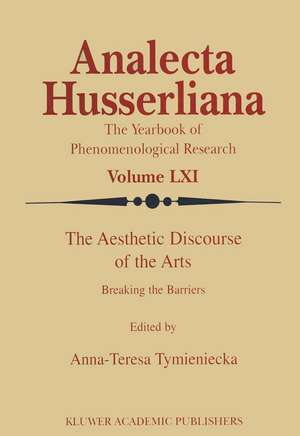The Aesthetic Discourse of the Arts: Breaking the Barriers: Analecta Husserliana, cartea 61
Editat de Anna-Teresa Tymienieckaen Limba Engleză Paperback – 5 noi 2012
This collection initiates an inquiry into the aesthetic foundations of the fine arts. Their common aesthetic nature, as well as the differentiating specificities which sustain them, might reveal the universal role of aesthetics in human life.
Studies by Paula Carabell, J. Fiori Blanchfield, R. Riese Hubert, R. Gray, D. Lipten, J. Parsons, S. Brown, C. Osowie Ruoff, T. Raczka, K. Karbenier and others.
Din seria Analecta Husserliana
- 17%
 Preț: 524.11 lei
Preț: 524.11 lei - 24%
 Preț: 815.01 lei
Preț: 815.01 lei - 20%
 Preț: 570.73 lei
Preț: 570.73 lei - 15%
 Preț: 643.00 lei
Preț: 643.00 lei - 18%
 Preț: 1984.67 lei
Preț: 1984.67 lei - 15%
 Preț: 636.12 lei
Preț: 636.12 lei - 15%
 Preț: 643.84 lei
Preț: 643.84 lei - 18%
 Preț: 952.57 lei
Preț: 952.57 lei - 18%
 Preț: 1222.01 lei
Preț: 1222.01 lei - 18%
 Preț: 950.52 lei
Preț: 950.52 lei - 15%
 Preț: 642.18 lei
Preț: 642.18 lei - 24%
 Preț: 1072.13 lei
Preț: 1072.13 lei - 18%
 Preț: 947.67 lei
Preț: 947.67 lei - 18%
 Preț: 1225.94 lei
Preț: 1225.94 lei - 24%
 Preț: 1075.49 lei
Preț: 1075.49 lei - 18%
 Preț: 949.73 lei
Preț: 949.73 lei - 15%
 Preț: 647.59 lei
Preț: 647.59 lei - 20%
 Preț: 577.73 lei
Preț: 577.73 lei -
 Preț: 386.22 lei
Preț: 386.22 lei - 15%
 Preț: 651.19 lei
Preț: 651.19 lei - 18%
 Preț: 960.42 lei
Preț: 960.42 lei -
 Preț: 390.08 lei
Preț: 390.08 lei - 18%
 Preț: 1128.89 lei
Preț: 1128.89 lei
Preț: 367.62 lei
Nou
Puncte Express: 551
Preț estimativ în valută:
70.35€ • 73.18$ • 58.08£
70.35€ • 73.18$ • 58.08£
Carte tipărită la comandă
Livrare economică 11-17 aprilie
Preluare comenzi: 021 569.72.76
Specificații
ISBN-13: 9789401058476
ISBN-10: 9401058474
Pagini: 300
Ilustrații: XIV, 281 p.
Dimensiuni: 152 x 223 x 16 mm
Ediția:Softcover reprint of the original 1st ed. 2000
Editura: SPRINGER NETHERLANDS
Colecția Springer
Seria Analecta Husserliana
Locul publicării:Dordrecht, Netherlands
ISBN-10: 9401058474
Pagini: 300
Ilustrații: XIV, 281 p.
Dimensiuni: 152 x 223 x 16 mm
Ediția:Softcover reprint of the original 1st ed. 2000
Editura: SPRINGER NETHERLANDS
Colecția Springer
Seria Analecta Husserliana
Locul publicării:Dordrecht, Netherlands
Public țintă
ResearchCuprins
Inaugural Essay.- The Creative Impulse and the Aesthetic Discourse of the Arts.- Section One.- Breaking the Frame: Transgression and Transformation in Giulio Romano’s Sala dei Giganti.- The nineteenth-Century Landscape and Twentieth-Century Space: Traumatic Loss or Trace of Memory? Robert Smithson and the Entrophic Metaphor.- Alechinsky, Cobra and the Book.- Aspiring to the Condition of Music: Hardy and His Art from the 1840s to the 1890s.- Counterpoint in Print: Okot p’Bitek’s Song of Lawino and Song of Ocol.- Section Two.- Semiotics and Musical Choice: “Beyond Analysis” Revisited.- When is a Work of Music Real?.- Section Three.- Machine-Time, Passion-Time, and Time that Trembles: Debussy and Baudelaire.- Baroque and Classical Aesthetic Visions.- To Consociate and Foster the Self.- Section four.- Inanimorata: The Dread of Things.- Musical and Visual Encounters: An Investigation of the Aesthetic Experience.- “…We Need Not Fear …” Expressivity and Silence in the Early Work of John Cage.- Berlioz’s Programme and Proust’s Sonate: Parallel Quests to Bridge the Gaps in Musico-Literary Expression.- Index of Names.


















